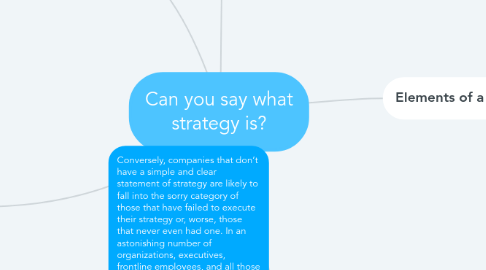
1. Conversely, companies that don’t have a simple and clear statement of strategy are likely to fall into the sorry category of those that have failed to execute their strategy or, worse, those that never even had one. In an astonishing number of organizations, executives, frontline employees, and all those in between are frustrated because no clear strategy exists for the company or its lines of business.
2. Defining the Objective
2.1. The fist element of a strategy stamen is the one that most companies have in some form or other. Companies tend to confuse their statement of values or their mission with their strategic objective. If your firm’s strategy can be applied to any other firm, you don’t have a very good one. The strategic objective should be specific, measurable, and time bound. It should also be a single goal.
3. Defining the Scope
3.1. A firm’s scope encompasses three dimensions: customer or offering, geographic location and vertical integration. The firm is configured to meet the needs of one very specific type of client. The scope of an enterprise does not prescribe exactly what should be done within the specified bounds. But to ensure that the bonders are clear to all employees, the scope should specify where the firm or business will not go.
4. Developing a Strategy Statement
4.1. The first step to create a great strategy, which requires careful evaluation of the industry landscape. This includes developing a detailed understanding of customer needs, segmenting customers, and then identifying unique ways of creating value for the ones the firm chooses to serve.
4.1.1. The process must involve a rigorous, objective assessment of the firm’s capabilities and resources and those of competitors. The creative part of developing strategy is finding the sweet spot that aligns the firm’s capabilities with costumer needs in a way that competitors cannot match given the changing external context.
4.1.2. The process of developing the strategy and then crafting the statement that captures its essence in a readily communicable manner should involve employees in all parts of the company and at all levels of the hierarchy. The wording of the strategy statement should be the most powerful part of the strategy development process.
5. What goes into a good statement of strategy?
5.1. Lays out the characteristics of strategy in a conceptual fashion, conveying the essence of strategic choices and distinguishing them from the relentless but competitively fruitless search for operational efficiency. It is a dirty little secret that most executives don’t actually know what all the elements of strategy statement are, which makes it impossible for them to develop one. With a clear definition, though, two things happen:
5.1.1. Formulation becomes infinitely easier because executives know what they are trying to create.
5.1.2. Implementation becomes much simpler because the strategy’s essence can be readily communicated and easily internalized by everyone in the organization.
6. Elements of a Strategy Statement
6.1. Mike Rukstad, identified three critical components of s good strategy statement – objective, scope and advantage. These elements are a simple yet sufficient list for any strategy that adderesses competitive interaction over unbounded terrain. Your competitive advantage is the essence of your strategy: What your business will do differently from or better that others defines the all-important means by which you will achieve your stated objective. Defining the objective, scope and advantage requires trade-offs, which Porter identified as fundamental to strategy.
7. Defining the Advantage
7.1. Advantage is the most critical aspect of a strategy statement. Clarity about what makes the firm distinctive is what most helps employees understand how they can contribute to successful execution of its strategy.
7.1.1. The complete definition of s firm’s competitive advantage consists of two parts.
7.1.1.1. The first is a statement of the costumer value proposition. Any strategy statement that cannot explain why customers should buy your product or service is doomed to failure.
7.1.1.2. The second part of the statement of advantage captures the unique activities or the complex combination of activities allowing that firm alone to deliver the customer value proposition.

